The Journal of Isaak Iselin: Seeing landscape
 The equivalent passage in the printed version of 1897.
The equivalent passage in the printed version of 1897.
Iselin, Isaac. Journal of a Trading Voyage Around the World, 1805–1808. New York: anon., 1897, p. 65.
Die Transkription lautet:
The land is much divided in small lots or
parcels, carefully separated by stone walls or a hedge of sugarcane which
grows to immense size. The paper–mulberry tree, taro root, yams etc.
potatoes, with few bread fruit and plenty of cocoanut trees are the
principal production we observed. Radishes and onions also grow in plenty.
But upon the whole the country exhibits a great want of hands to improve it.
The depopulation is evident and may in some manner be accounted for by the
absence of the chiefs and warriors and still more for a kind of epidemic or
or [sic] yellow fever said to have been brought to these islands a few years
ago and which makes dreadful havoc amongst the natives.-
A comparison of the two versions of the passage reveals great differences in meaning: where in the original journal the land is described as «barren», in this version agricultural products grow «in plenty». But Iselin goes on to mention the alleged neglect of the Hawaiians for their soil—a point which is somewhat contradictory, given the number of the products listed. Iselin thus seems to be playing into the contemporaneous trope of Hawaiʻi as a potential agricultural paradise waiting to be cultivated by EuroAmerican hands. In this context, his reference to sugarcane is significant, because from the 1830s onwards, EuroAmerican businessmen started to develop sugarcane plantations—first on a small scale, but eventually (by the late–nineteenth century) in a way that fundamentally transformed Hawaiian landscapes and ecologies.
In terms of disease, Iselin writes that an epidemic was «said to have been brought to these islands a few years ago.» This passive formulation omits the agent of the disease(s), namely EuroAmerican traders who came to Hawaiʻi in the two or three decades before the Maryland.
In the original journal, this entry is dated June 26th; in the edited version, May 24th. It is not clear why the dates are different, considering that both entries concern Kealakekua Bay.
